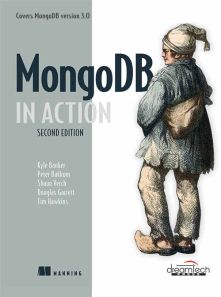The store will not work correctly when cookies are disabled.
JavaScript seems to be disabled in your browser.
For the best experience on our site, be sure to turn on Javascript in your browser.
MongoDB in Action, 2ed: Covers MongoDB Version 3.0
Description
MongoDB in Action, Second Edition is a completely revised and updated version. It introduces MongoDB 3.0 and the document-oriented database model. This perfectly paced book gives you both the big picture you’ll need as a developer and enough low-level detail to satisfy system engineers. Lots of examples will help you develop confidence in the crucial area of data modeling. You’ll also love the deep explanations of each feature, including replication, auto-sharding and deployment.
Part 1 Getting Started
1. A database for the modern web
1.1. Built for the internet
1.2. MongoDB's key features
1.3. MongoDB's core server and tools
1.4. Why MongoDB?
1.5. Tips and limitations
1.6. History of MongoDB
1.7. Additional resources
1.8. Summary
2. MongoDB through the JavaScript shell
2.1. Diving into the MongoDB shell
2.2. Creating and querying with indexes
2.3. Basic administration
2.4. Getting help
2.5. Summary
3. Writing programs using MongoDB
3.1. MongoDB through the Ruby lens
3.2. How the drivers work
3.3. Building a simple application
3.4. Summary
Part 2: Application development in MongoDB
4. Document-oriented data
4.1. Principles of schema design
4.2. Designing an e-commerce data model
4.3. Nuts and bolts: On databases, collections, and documents
4.4. Summary
5. Constructing queries
5.1. E-commerce queries
5.2. MongoDB's query language
5.3. Summary
6. Aggregation
6.1. Aggregation framework overview
6.2. E-commerce aggregation example
6.3. Aggregation pipeline operators
6.4. Reshaping documents
6.5. Understanding aggregation pipeline performance
6.6. Other aggregation capabilities
6.7. Summary
7. Updates, atomic operations, and deletes
7.1. A brief tour of document updates
7.2. E-commerce updates
7.3. Atomic document processing
7.4. Nuts and bolts: MongoDB updates and deletes
7.5. Reviewing update operators
7.6. Summary
Part 3: MongoDB mastery
8. Indexing and query optimization
8.1. Indexing theory
8.2. Indexing in practice
8.3. Query optimization
8.4. Summary
9. Text search
9.1. Text searches—not just pattern matching
9.2. Manning book catalog data download
9.3. Defining text search indexes
9.4. Basic text search
9.5. Aggregation framework text search
9.6. Text search languages
9.7. Summary
10. WiredTiger and pluggable storage
10.1. Pluggable Storage Engine API
10.2. WiredTiger
10.3. Comparison with MMAPv1
10.4. Other examples of pluggable storage engines
10.5. Advanced topics
10.6. Summary
11. Replication
11.1. Replication overview
11.2. Replica sets
11.3. Drivers and replication
11.4. Summary
12. Scaling your system with Sharding
12.1. Sharding overview
12.2. Understanding components of a sharded cluster
12.3. Distributing data in a sharded cluster
12.4. Building a sample shard cluster
12.5. Querying and indexing a shard cluster
12.6. Choosing a shard key
12.7. Sharding in production
12.8. Summary
13. Deployment and administration
13.1. Hardware and provisioning
13.2. Monitoring and diagnostics
13.3. Backups
13.4. Security
13.5. Administrative tasks
13.6. Performance troubleshooting
13.7. Deployment checklist
13.8. Summary
Appendixes
Appendix A: Installation
A.1. Installation
A.2. MongoDB on Linux
A.3. MongoDB on Mac OS X
A.4. MongoDB on Windows
A.5. Compiling MongoDB from source
A.6. Troubleshooting
A.7. Basic configuration options
A.8. Installing Ruby
Appendix B: Design patterns
B.1. Embed vs. reference
B.2. One-to-many
B.3. Many-to-many
B.4. Trees
B.5. Worker queues
B.6. Dynamic attributes
B.7. Transactions
B.8. Locality and precomputation
B.9. Antipatterns
Appendix C: Binary data and GridFS


